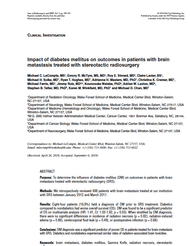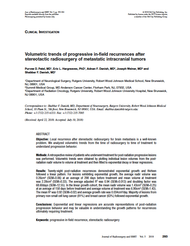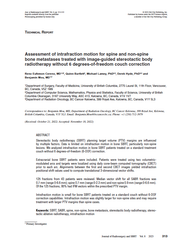- Home
- Journal Contents Downloads
- JRSBRT Downloads
- JRSBRT 5.4, p. 305-313
Product Description
Selective and super-selective C-arm based cone beam CT angiography (CBCTA) with DynaCT for Cyberknife radiosurgery planning of intracranial arteriovenous malformations (AVMs)
Oliver Edwin Holmes, Janos Szanto, Vered Tsehmaister Abitbul, Taleb Al Mansoori, Hanan Alqahtani, John Sinclair, Daniela Iancu and Shawn Malone
Background: Successful radiosurgery for intracranial arteriovenous malformations (AVMs) requires accurate delineation of the nidus in 3D. Exact targeting and precise equipment is needed to achieve obliteration of the nidus while minimizing toxicity to the surrounding brain. In some micro-AVMs and poorly visible AVMs we have used cone beam CT angiography (CBCTA) with selective and super-selective angiography -where a micro-catheter is advanced into the feeding arteries- to assist with nidus definition for CyberKnife radiosurgery planning.
Methods: Four patients who had AVMs inadequately visualized with MRI, MRA, CT, CTA, and dynamic CT angiography (dCTA) were identified for selective angiography (2 had super-selective angiography) for CyberKnife radiosurgery. The mean age at the time of treatment was 45 years (range: 22 – 71 years). All patients had suffered prior hemorrhage and were deemed inoperable. Super-selective angiography was done under general anesthesia to minimize motion artefact and the risk of arterial dissection. Angiography was performed using the biplane angiographic suite (ArtisQ; Siemens). Cone beam reconstructions were performed using DynaCT software. For each scan, volumetric data was acquired over 20 seconds in a single rotation of the C-arm mounted flat-panel detector cone-beam CT system. The data set was imported into the CyberKnife TPS and co-registered with the treatment planning CT, T2 MRI and Toshiba dCTA. Delineation of the AVM nidus was performed by the multi-disciplinary AVM team.
Results: There were no adverse events related to the angiography or radiosurgery treatment. CBCTA data sets created using DynaCT were accurately co-registered with the treatment planning scans in the CyberKnife treatment planning system (Multiplan). For all 4 patients, feeding arteries, draining veins and nidi were clearly visualized and used to develop radiosurgery plans. Mean nidus size was 0.45cc (range: 0.07 – 1.00cc).
Conclusions: For intracranial micro-AVMs and AVMs otherwise poorly visualized using DSA, MRA, CTA or dCTA, selective and super-selective CBCTA images (created using DynaCT) can be successfully imported into the CyberKnife TPS to assist in nidus delineation. Advancement of a micro-catheter into the feeding arteries to allow continuous contrast injection during volumetric scanning constitutes super-selective CBCTA. This technique provides superior visualization of micro-AVMs and should be utilized for radiosurgery planning of poorly visualized AVMs.
Keywords: radiosurgery, arteriovenous malformations, C-arm based cone beam CT angiography (CBCT-A), CyberKnife radiosurgery, selective angiography, intracranial arteriovenous malformation
After payment has been processed for your order of a digital copy (PDF) of this article, you will see a download link on your completed order page and also receive an email containing a download link. The links, which will enable you to download one copy of the article, will expire after 24 hours.
 Loading... Please wait...
Loading... Please wait...








